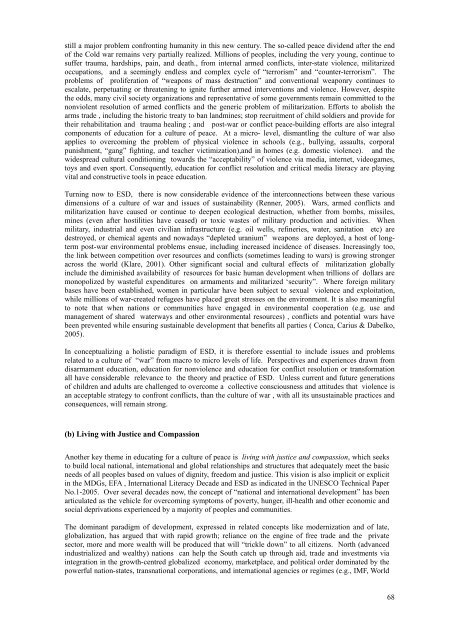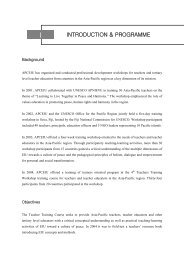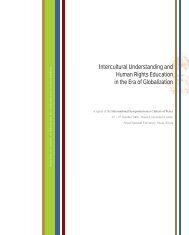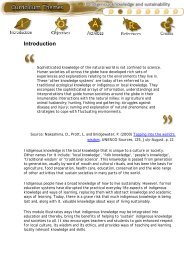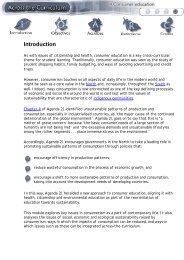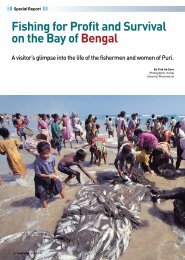REPORT OF UNESCO EXPERT MEETING ON - APCEIU
REPORT OF UNESCO EXPERT MEETING ON - APCEIU
REPORT OF UNESCO EXPERT MEETING ON - APCEIU
Create successful ePaper yourself
Turn your PDF publications into a flip-book with our unique Google optimized e-Paper software.
still a major problem confronting humanity in this new century. The so-called peace dividend after the end<br />
of the Cold war remains very partially realized. Millions of peoples, including the very young, continue to<br />
suffer trauma, hardships, pain, and death., from internal armed conflicts, inter-state violence, militarized<br />
occupations, and a seemingly endless and complex cycle of “terrorism” and “counter-terrorism”. The<br />
problems of proliferation of “weapons of mass destruction” and conventional weaponry continues to<br />
escalate, perpetuating or threatening to ignite further armed interventions and violence. However, despite<br />
the odds, many civil society organizations and representative of some governments remain committed to the<br />
nonviolent resolution of armed conflicts and the generic problem of militarization. Efforts to abolish the<br />
arms trade , including the historic treaty to ban landmines; stop recruitment of child soldiers and provide for<br />
their rehabilitation and trauma healing ; and post-war or conflict peace-building efforts are also integral<br />
components of education for a culture of peace. At a micro- level, dismantling the culture of war also<br />
applies to overcoming the problem of physical violence in schools (e.g., bullying, assaults, corporal<br />
punishment, “gang” fighting, and teacher victimization),and in homes (e.g. domestic violence). and the<br />
widespread cultural conditioning towards the “acceptability” of violence via media, internet, videogames,<br />
toys and even sport. Consequently, education for conflict resolution and critical media literacy are playing<br />
vital and constructive tools in peace education.<br />
Turning now to ESD, there is now considerable evidence of the interconnections between these various<br />
dimensions of a culture of war and issues of sustainability (Renner, 2005). Wars, armed conflicts and<br />
militarization have caused or continue to deepen ecological destruction, whether from bombs, missiles,<br />
mines (even after hostilities have ceased) or toxic wastes of military production and activities. When<br />
military, industrial and even civilian infrastructure (e.g. oil wells, refineries, water, sanitation etc) are<br />
destroyed, or chemical agents and nowadays “depleted uranium” weapons are deployed, a host of longterm<br />
post-war environmental problems ensue, including increased incidence of diseases. Increasingly too,<br />
the link between competition over resources and conflicts (sometimes leading to wars) is growing stronger<br />
across the world (Klare, 2001). Other significant social and cultural effects of militarization globally<br />
include the diminished availability of resources for basic human development when trillions of dollars are<br />
monopolized by wasteful expenditures on armaments and militarized ‘security”. Where foreign military<br />
bases have been established, women in particular have been subject to sexual violence and exploitation,<br />
while millions of war-created refugees have placed great stresses on the environment. It is also meaningful<br />
to note that when nations or communities have engaged in environmental cooperation (e.g. use and<br />
management of shared waterways and other environmental resources) , conflicts and potential wars have<br />
been prevented while ensuring sustainable development that benefits all parties ( Conca, Carius & Dabelko,<br />
2005).<br />
In conceptualizing a holistic paradigm of ESD, it is therefore essential to include issues and problems<br />
related to a culture of “war” from macro to micro levels of life. Perspectives and experiences drawn from<br />
disarmament education, education for nonviolence and education for conflict resolution or transformation<br />
all have considerable relevance to the theory and practice of ESD. Unless current and future generations<br />
of children and adults are challenged to overcome a collective consciousness and attitudes that violence is<br />
an acceptable strategy to confront conflicts, than the culture of war , with all its unsustainable practices and<br />
consequences, will remain strong.<br />
(b) Living with Justice and Compassion<br />
Another key theme in educating for a culture of peace is living with justice and compassion, which seeks<br />
to build local national, international and global relationships and structures that adequately meet the basic<br />
needs of all peoples based on values of dignity, freedom and justice. This vision is also implicit or explicit<br />
in the MDGs, EFA , International Literacy Decade and ESD as indicated in the <strong>UNESCO</strong> Technical Paper<br />
No.1-2005. Over several decades now, the concept of “national and international development” has been<br />
articulated as the vehicle for overcoming symptoms of poverty, hunger, ill-health and other economic and<br />
social deprivations experienced by a majority of peoples and communities.<br />
The dominant paradigm of development, expressed in related concepts like modernization and of late,<br />
globalization, has argued that with rapid growth; reliance on the engine of free trade and the private<br />
sector, more and more wealth will be produced that will “trickle down” to all citizens. North (advanced<br />
industrialized and wealthy) nations can help the South catch up through aid, trade and investments via<br />
integration in the growth-centred globalized economy, marketplace, and political order dominated by the<br />
powerful nation-states, transnational corporations, and international agencies or regimes (e.g., IMF, World<br />
68


